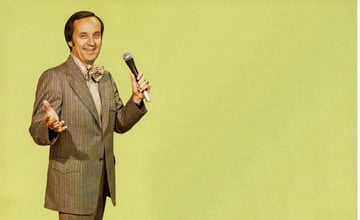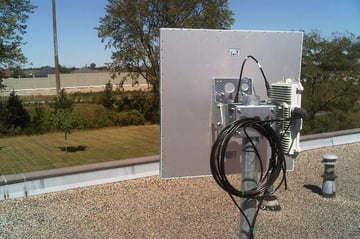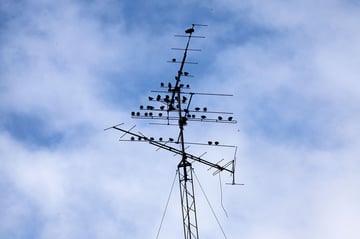Big Changes for Wireless Audio Industry in Store, Reveals New FCC Document

On Tuesday, the FCC convened to discuss wireless microphone regulation at the September Open Commission Meeting. The ensuing Notice of Proposed Rulemaking hints at exciting, or scary, possibilities for the wireless audio industry, depending on your perspective.
[Update: Our discussion on the second NPRM is here.]
Although nothing is set in stone, this is still important stuff. The NPRM is a call to action for industry representatives and end-users to make their voices heard on future regulatory changes. The document does not constitute any law in itself. It provides regulatory trajectories that the Commission is considering while offering the public an opportunity to weigh in on the issues.
Those trajectories, however preliminary, will inform how wireless microphones operate in the future.
At the top of the list is the possibility of allowing wireless audio equipment to operate in a larger number of frequency bands than is currently allowed. The bulk of new wireless audio allocations seem to be for licensed, Part 74 users. New spectrum discussed for potential use by unlicensed Part 15 devices is limited.
There is also discussion on other important topics, like the amendement of Part 74 rules and cutoff dates for the manufacture of 600 MHz wireless audio equipment.
First up, wireless audio is getting new spectrum. Where, when, and for what types of devices are all up for debate, but the possibilities are many. They include:
- 26.1-26.48 MHz, 161.625-161.775 MHz, 450-451 MHz, and 455-456 MHz. This doesn’t sound like much but, as we have said before, every slice of spectrum is valuable, and every bit that is available to offload devices of secondary importance (like intercoms) from prime UHF spectrum, the better.
- 88-108 MHz. Yes! This is broadcast radio FM spectrum. Perhaps a descendant of Mr. Microphone will be used by professionals, as well as children and clownish adults. Since the manufacture of low power FM transmitters is allowed for cigarette lighter transmitters, this actually makes more sense than it does at first pass. The suitability of broadcast FM spectrum for multiple and long-range wireless audio links may not be very good, though.
- 169-172 MHz VHF, currently allocated to public safety and industrial applications, as well as an extremely limited number of <50 mW wireless mic licenses on only eight frequencies. Operation here is narrowbanded to a dainty 12.5 kHz. Wireless audio would be of low quality under current rules, although the Commission expresses interest in revising the rules. It seems open-ended enough to allow for the possibility of unlicensed operations as well, but I wouldn’t count on it.
- 944-952 MHz, 941-944 MHz, and 952-960 MHz. Expanding access to all parties eligible for Part 74, not just film and broadcast users.
- 944-952 MHz. Again, expanding eligibility from broadcast only Part 74 users to all Part 74 users under the new rules for the UHF broadcast band.
- 941-944 MHz, and 952-960 MHz. Currently home to many delightfully obscure broadcast and industrial ephemera, such as municipal SCADA. Operation here is being considered for Part 74 users.
- 1435-1525 MHz. Used for aeronautical, federal, and military applications, the Commission reports that event production companies have acquired Special Temporary Authority licenses (STAs) to use up to 90 MHz of spectrum for special events, and proposes opening the doors to this spectrum to other professional licensed users. Coordination and protection of incumbents seems to be a priority, more so than the other bands mentioned.
- Revising Part 15 rules in the 900 MHz, 2.4 GHz, and 5 GHz ISM bands, and 1920-1930 MHz PCS or “DECT” band to better suit the needs of wireless audio users. This is discussed at greater length in a companion NPRM, see end of post.
- 3.5 GHz. Any operation here will fall under the yet to be finalized rules for the “Citizen’s Broadband Radio Service,” which Jessica Rosenworcel mentioned in her recent speech on unlicensed spectrum. Right now it appears unlicensed rules are geared towards cognitive data devices like TVBDs, with more or less suitability for real time wireless audio. The tiered model of incumbancy needs further investigation. I’m holding out hope that unlicensed microphones will be allowed here, and the rules revised in such a way to allow microphones to thrive.
- 6.8 GHz - 7.1 GHz. They propose allowing a greater variety of licensed users here. Propagation characteristics of frequencies this high are undesirable. Hopefully transmission limits are upped to allow for 100 meter + operation.
- UWB in 3 - 10 GHz. Seems to include unlicensed operation. Modulation of signal by very low power, ultra wideband RF pulses over short distances, á la Audio Technica’s “Spectra Pulse” system.
Other matters:
- Revising power rules in VHF for Part 74 to allow 250 mW operation, instead of 50 mW
- Should licensed wireless microphones be allowed to operate closer to TV stations within a given TV stations channel than the current rules allow? - The FCC here proposes not a defined radius, but rather allowing operation at any location with a received TV signal strength below a certain threshold. This means Part 74 users could now operate indoors, even if they are near a TV transmitter.
- Requiring wireless audio devices to adhere to a stricter and slimmer spectral footprint, or “requiring wireless microphones to meet...tighter emission requirements [over 200 kHz channels] in Section 8.3 of ETSI EN 300 422-1.
- Expanding eligibility for Part 74 operation in the newly created duplex gap to include both newly eligible users (ie., “50 devices or more”), or only broadcast and film license holders. This is explored more in the accompanying NPRM docket 14-165.
- Expanding consumer outreach and product disclosure literature to better educate consumers on permitted bands of operation and events of the incentive auctions.
- Establishing cutoff dates for the prohibition of manufacture of wireless audio devices in the 600 band.
- We learn that the total number of licensed wireless audio users is only 1,200, with 600 of them being specific to UHF. Only 1,200 in the entire United States. This number is likely to rise sharply since the eligibility requirements have been expanded to include any entity that routinely uses 50 or more devices.
The FCC is also considering amendments to Part 15, which regulates unlicensed wireless services. This information is contained in a separate 95 page NPRM, “Amendment of Part 15 of the Commission’s Rules for Unlicensed Operations in the Television Bands, Repurposed 600 MHz Band, 600 MHz Guard Bands and Duplex Gap, and Channel 37, and Amendment of Part 74 of the Commission’s Rules for Low Power Auxiliary Stations in the Repurposed 600 MHz Band and 600 MHz Duplex Gap”
We will dip into and summarize this document as well, but not today.
Alex Milne
Alex Milne was Product Marketing Manager and Digital Marketing Manager for RF Venue, and a writer for the RF Venue Blog, from 2014-2017. He is founder and CEO of Terraband, Inc., a networking and ICT infrastructure company based in Brooklyn, NY., and blogs on spectrum management, and other topics where technology,...
More from the blog

Is VHF the Answer to the Spectrum Crunch?

What Is a White Space Device? Everything You Need to Know about TV Band Devices (TVBDs), and More...

LPTVs and Wireless Microphones: Friends?
Subscribe to email updates
Stay up-to-date on what's happening at this blog and get additional content about the benefits of subscribing.

